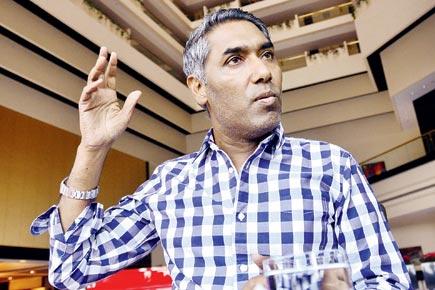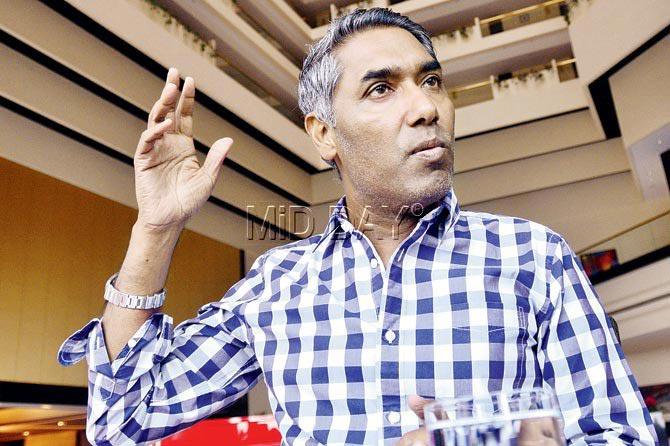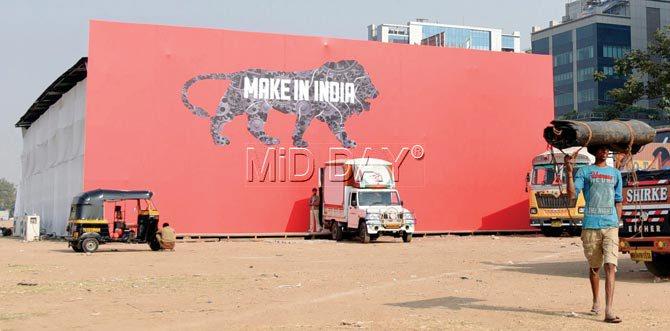49-year-old Sunil Vysyaprath, the man behind the phrase Make in India, talks about what it takes to glam up government projects

ADVERTISEMENT
It is countdown to Make in India Week (February 13-18) in the city, and the mascot — the lion made of gear-like chakras — is on the prowl at Bandra Kurla Complex (BKC). It is hard to pin down Make in India Week in a few words but here are the facts: the city is undergoing a facelift; BKC will host the headquarters where investors will converge, hoping for a lion’s share of the future of Indian manufacturing; Maha-rashtra Night is on Valentine’s day; there will be a generous sprinkling of art and design events. Call it a carnival or business convention, but Sunil Vysyaprath terms it Mumbai Takeover.

Sunil Vysyaprath. Pic/Bipin Kokate
He is a man of catchphrases, and this is not his first project. The adman put the exclamation mark in Incredible India in
2001, loaned Royal Enfield the iconic Trip series, turned IndiGo Airlines’ snack boxes into witty collectibles, and more recently, sold us the idea that has been received as Modi’s ultimate pet project.
At 49, Vysyaprath is a determined strategian. His ad strategies put a glamorous spin to what could have been drab sarkari affairs. The slick Make in India launch in September 2014, replete with a mobile-friendly website and a 24-foot LED screen, was proof enough.

At BKC, preparations are on for Make in India Week. Pic/Sameer Markande
We caught up with Vysyaprath, three days after news of his moving out of Weiden + Kennedy, Delhi, hit the streets. Edited excerpts from the interview.
Q. How was Make in India born?
A. It was started a year and a half ago. The government wanted a campaign for foreign investment and to push for better manufacturing. So, even we had ideas like "Invest in India" — all the classic clichés. Somewhere, we came up with Make in India. Some people thought it sounded incorrect. Some people wanted a tiger for the logo, for no reason at all.
Q. Because it’s the national animal?
A. And, also because tigers are dying. Then we thought of the lion because it is on your passport and currency; it’s the strongest symbol we ever had. If you look at our history, as a strong symbol – there is nothing! Even [for] our 50th year of Independence, we did that little swirly tiranga – that has been our style. We wanted to tell the world that India is now more than just ready.
Q. You mentioned there were concerns about ‘Make in India’ being poor English. Was Made in India an option?
A. I told my friend [Mohit Jayal, director Weiden + Kennedy Delhi], "Here is the idea: Make in India." He said, "That sounds like incorrect English, but it could work." Then I called up Amitabh Kant [secretary of Department of Industrial Policy and Promotion (DIPP)]. He asked, "Sure, na?" I told him it would make it to newspaper headlines.
Q. What do you think the public sector image needs?
A. Earlier, it would just go to the Directorate of Advertising and Visual publicity (DAVP). That was their agency. In the last
10 years, the government has been going to [independent] agencies. I have been lucky there is someone like Amitabh Kant. With him, and the government’s backing, you’d be a fool not to take up something so ambitious.
Q. While Make in India sounds muscular and industrial, you seem to have introduced a lot of art and culture in Make in India Week. Why?
A. If you don’t bring design and art into Make in India, you cannot get young people excited about manufacturing. Secondly, thi. 0s time, people are coming here to invest. We need to show them what Mumbai is made of. For example, there is a historical textile show by top designers planned at CSMVS, galleries are going to be kept open, and so on. Without design and aesthetics, manufacturing remains just manufacturing.
Q. What you speak of — quality design — is also the criticism that Make in India has received. In 2014, RBI governor Raghuram Rajan warned that it is not enough to focus on an export- driven market. This week, Nobel Laureates at the Indian Science Congress, Mysuru, have stressed the importance of Discover in India and Invent in India, and not just Make in India.
A. A lot of international products, such as Airbus parts and landing gears, are being manufactured here, but people don’t really know. Make in India is not like a tourism campaign where there is an ad and tourists will start coming to the Taj Mahal. In our presentation, we had said we need to imagine Make in India like the like the start of Industrial Revolution II; it was for everyone to understand the scale.
I tell people that this is an invitation. If everything was well, we wouldn’t be calling for "Make in India"; we would just be making, right? On ground, so many things are still the same. It is going to take time, another 10 years.
Q. Do you think criticism is levied against Make in India because Modi leads it?
A. Possibly. But it would not have reached this international scale in such a short time otherwise.
Q. After your firm "A" merged with Weiden + Kennedy Delhi, you have quit to start a new venture. What is the move about? You say you are done with advertising.
A. We have been planning our departure from Weiden + Kennedy for two years, and talking to the agency about it. A company like Weiden + Kennedy or talent like ours can’t be doing the same thing all the time. We have to keep evolving. The new company, with Mohit Jayal, will, among other things, take our magazine Motherland ahead and turn it into a new animal. I will continue as a consultant with Make in India.
Q. Motherland is known for its counter-voice and representation of India’s subcultures. It’s about the fringe. On the other hand, nothing can get more mainstream than Modi-driven Make in India. Who is the real Sunil then?
A. It is important for me to package India smartly and strongly, whether it is an ad product, Kochi Biennale [where he is a trustee] or Motherland. We have got to mix all of these things because one thing will help the other. Even for the Biennale, our connections all over the world get used for us to do something worthwhile in Kochi. It’s hardcore business on one side and some alternative projects like Kochi Biennale and Motherland on the other [for us].
Q. And, what if Modi is not around as PM for 10 years? What happens to Make in India?
A. Modi is the brand ambassador for Make in India as Prime Minister. It is not a BJP campaign. It’s a DIPP campaign.
 Subscribe today by clicking the link and stay updated with the latest news!" Click here!
Subscribe today by clicking the link and stay updated with the latest news!" Click here!







